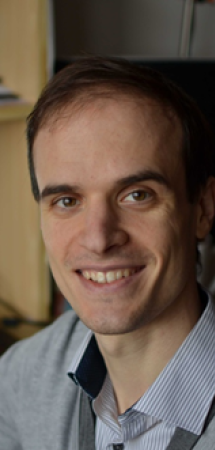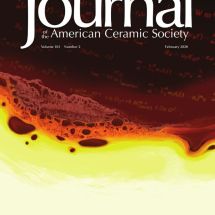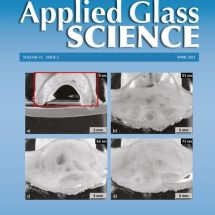
| E-mail: | richard.pokorny@vscht.cz |
|
Phone: |
+420 220 44 4318 |
| Room: |
A 04 |
| Scholar | |
| Scopus | |
| ORCID |
Research
Richard is a head of the vitrification group at the University of Chemistry and Technology in Prague, Czech Republic. He specializes in the development of mathematical models for both fundamental and applied research. In recent years, he co-leads the development of the mathematical model of a cold cap, which will be used in support of the Waste Treatment and Immobilization Plant, currently built at Hanford, Washington, USA. Richard is interested in all kinds of problems related to batch-to-glass conversion and melter modeling.
Occupation and employer
- 02/2016 – today: Researcher/Principal Investigator at UCT Prague, Faculty of Chemical Technology. Established a new research group in the field of glass science
- 2010 – 2015: Research Associate (2010 – 2011) / Contractor (2011 – 2015) at Pacific Northwest National Laboratory, Richland, Washington, USA, Project: Mathematical Modeling of Cold Cap during Vitrification of Nuclear Waste.
Education
- 2011-2016: UCT Prague, Faculty of Chemical Engineering, PhD studies in Mathematical Modeling in Chemical Engineering, PhD thesis: "Modeling of structure-property relationships in hetero-phase materials"
- 2005-2010: UCT Prague, Faculty of Chemical Engineering, Bachelor and Master’s Degree in Chemical Engineering, Bioengineering and Modeling of Processes.
Current projects
- The Ministry of Education, Youth and Sports of the Czech Republic, program Inter-Excellence – Inter-Action II, USA, č. LUAUS23062: Experimental and mathematical analysis of primary glass-forming melt properties, gas evolution, and their relation with primary foam production. (2023 – 2026)
- Battelle Energy Alliance, LLC, Idaho, USA, Contract No. 166789: Mathematical Modeling and Experimental Evaluation of Melter Cold Cap for Nuclear Waste Vitrification (2016-2024)
Past projects
- The Ministry of Education, Youth and Sports of the Czech Republic, program Inter-Excellence – Inter-Action, USA, č. LTAUSA18075: Analysis of Foaming – Critical Batch-to-Glass Conversion Process. (2019 – 2022)
- GACR, project No. 19-14179S: In-situ analysis of foam layer behavior at the batch-melt interface using laboratory-scale melter vessel (2019 - 2021)
- Battelle Energy Alliance, LLC, Idaho, USA, Contract No. 206349: Batch-to-Glass Conversion and Chemical Durability of Glass for Vitrification of Low Activity Waste (2018-2019)
Other area of interest
- 2011 (04-06), 2012 (05-06), 2013 (04-05): Visiting researcher at the Division of Advanced Nuclear Engineering, Pohang University of Science and Technology, South Korea (Project: Mathematical modeling of fundamental processes affecting the melting rate in electric glass melters. Description: Three consecutive Ph.D. internships at the Division of Advanced Nuclear Engineering under the “World Class University Programme”.)
Recent Publications
2023
- Kunc J., Kloužek J., Vernerová M., Cincibusová P., Ferkl P., Hall M., Eaton W., Hrma P., Guillen D., Kruger A., Pokorný R. (2023): Effect of feed composition on the production of off-gases during vitrification of simulated low-activity nuclear waste. Progress in Nuclear Energy. 166, 104932. doi: 10.1016/j.pnucene.2023.104932
- Ferkl P., Hrma P., Kloužek J., Kruger A., Pokorný R. (2023): Cold-cap structure in a slurry-fed electric melter. International Journal of Applied Glass Science. doi: 10.1111/ijag.16645.
- Pokorný R., Vernerová M., Kloužek J., Cincibusová P., Kohoutková M., Pezl R., Ferkl P., Hrma P., Podor R., Schuller S.,Kruger A. (2023): Transient Melt Formation and its Effect on Conversion Phenomena during Nuclear Waste Vitrification – HT-ESEM Analysis. Journal of the American Ceramic Society. doi: 10.1111/jace.19361
- Ferkl P., Hrma P., Klouzek J., Kruger A., Pokorny R. (2023): Effect of material properties on batch-to-glass conversion kinetics. International Journal of Applied Glass Science. doi: 10.1111/ijag.16631
- Rigby J.C., Dixon D.R., Kloužek J., Pokorný R., Thompson P.B.J., Scrimshire A., Kruger A.A., Bell A.M.T., Bingham P.A. (2023): Alternative reductants for foam control during vitrification of high-iron High Level Waste (HLW) feeds. Journal of Non-Crystalline Solids. 608, 122240. doi: 10.1016/j.jnoncrysol.2023.122240
- Ferkl P., Hrma P., Abboud A., Guillen D., Vernerová M., Kloužek J., Hall M., Kruger A., Pokorny R. (2023): Conversion degree and heat transfer in the cold cap and their effect on glass production rate in an electric melter. International Journal of Applied Glass Science. doi: 10.1111/ijag.16615
- Marcial J., Cicconi M., Pearce C., Klouzek J., Neeway J., Pokorny R., Vernerova M., McCloy J., Nienhuis E., Sjoblom R., Weaver J., Hand R., Hrma P., Neuville D., Kruger A. (2023): Effect of network connectivity on behavior of synthetic Broborg Hillfort glasses. Journal of the American Ceramic Society. 106, 1716. doi: 10.1111/jace.18778
- Khawand J., Kloužek J., Vernerová M., Cincibusová P., Hrma P., Kruger A., Pokorný R. (2023): Effect of Sucrose on the Oxidation-Reduction Conditions and Retention of Rhenium during Vitrification of Low-Activity Waste. Journal of Nuclear Materials. 573, 154155. doi: 10.1016/j.jnucmat.2022.154155.
2022
- Rigby J., Dixon D., Cutforth D., Marcial J., Klouzek J., Pokorny R., Kruger A., Scrimshire A., Bell M., Bingham P. (2022): Melting behaviour of simulated radioactive waste as functions of different redox iron-bearing raw materials. Journal of Nuclear Materials. 569, 153946. doi: 10.1016/j.jnucmat.2022.153946
- Marcial J., George J., Ferkl P., Pokorny R., Kissinger R., Crum J., Klouzek J., Hrma P., Kruger A., (2022): Elemental mapping and iron oxidation state measurement of synthetic low-activity waste feeds. Journal of Non-Crystalline Solids. 591, 121725. doi: 10.1016/j.jnoncrysol.2022.121725
- Ferkl P., Hrma P., Abboud A., Guillen D., Khawand J., Kopal I., Kohoutková M., Vernerová M., Kloužek J., Hall M., Kruger A., Pokorný R. (2022): Conversion kinetics during melting of simulated nuclear waste glass feeds measured by dissolution of silica. Journal of Non-Crystalline Solids. 579, 121363. doi: 10.1016/j.jnoncrysol.2021.121363
- Marcial J., Luksic S., Klouzek J., Vernerova M., Cutforth D., Varga T., Hrma P., Kruger A., Pokorny R. (2022): In-situ x-ray and visual observation of foam morphology and behavior at the batch-melt interface during melting of simulated waste glass. Ceramics International. 48, 7975-7985. doi: 10.1016/j.ceramint.2021.11.344
- Marcial J., Kloužek J., Vernerová M, Ferkl P., Lee S., Cutforth D., Hrma P., Kruger A., Pokorný R. (2022): Effect of Al and Fe sources on conversion of high-level nuclear waste feed to glass. Journal of Nuclear Materials. 559, 153423. doi: 10.1016/j.jnucmat.2021.153423
2021
- Kloužek J., Cincibusová P., Vernerová M., Hrma P., Pokorný R. (2021): Visual observation of foaming at the batch-melt interface during melting of soda-lime-silica glass. Ceramics-Silikaty 65, 410-416. doi: 10.13168/cs.2021.0044
- Ferkl P., Hrma P., Kloužek J., Vernerová M., Kruger A., Pokorný R. (2021): Model for batch-to-glass conversion: Coupling the heat transfer with conversion kinetics. Journal of Asian Ceramic Societies. 9, 652-664. doi: 10.1080/21870764.2021.1907914
- Lee S., Cutforth D., Mar D., Klouzek J., Ferkl P., Dixon D., Pokorny R., Hall M., Eaton W., Hrma P., Kruger A. (2021): Melting rate correlation with batch properties and melter operating conditions during conversion of nuclear waste melter feeds to glasses. International Journal of Applied Glass Science. 12, 398-414. doi: 10.1111/ijag.15911
- Luksic S., Pokorny R., Hrma P., Varga T., Rivers E., Buchko A., Klouzek J., Kruger A. (2021): Through a glass darkly: In-situ x-ray computed tomography imaging of feed melting in continuously fed laboratory-scale glass melter. Ceramics International. 47, 15807-15818. doi: 10.1016/j.ceramint.2021.02.153
- Abboud A., Guillen D., Hrma P., Kruger A., Klouzek J., Pokorny R. (2021): Heat Transfer from Glass Melt to Cold Cap: Computational Fluid Dyamics Study of Cavities beneath Cold Cap. International Journal of Applied Glass Science. 12, 233-244. doi: 10.1111/ijag.15863
- Marcial J., Pokorný R., Kloužek J., Vernerová M., Lee S., Hrma P., Kruger A. (2021): Effect of water vapor and thermal history on nuclear waste feed conversion to glass. International Journal of Applied Glass Science. 12, 145-157. doi: 10.1111/ijag.15803
- Ueda N., Vernerová M., Kloužek J., Ferkl P., Hrma P., Yano T., Pokorný R. (2021): Conversion kinetics of container glass batch melting. 103, 34-44. Journal of the American Ceramic Society. doi: 10.1111/jace.17406
2020
- Lee S., Ferkl P., Pokorny R., Klouzek J., Hrma P., Eaton W., Kruger A. (2020): Simplified melting rate correlation for radioactive waste vitrification in electric furnaces. Journal of the American Ceramic Society. 103, 5573-5578. doi: 10.1111/jace.17281
- Luksic S., Pokorny R., Jaime G., Hrma P., Varga T., Reno L., Buchko A., Kruger A. (2020). In situ characterization of foam morphology during melting of simulated waste glass using x-ray computed tomography. Ceramics International. 46, 17176-17185. doi: 10.1016/j.ceramint.2020.02.215
- Abboud A.W., Guillen D.P., Pokorny R. (2020): Effect of Cold Cap Coverage and Emissivity on the Plenum Temperature in a Pilot‐Scale Waste Vitrification Melter. International Journal of Applied Glass Science. doi: 10.1111/ijag.15031
- Hujova M., Klouzek J., Cutforth, D., Lee S., Miller M., Kruger A., Hrma P., Pokorny R. (2020): Feed-to-glass conversion during low activity waste vitrification. Ceramics International. doi: 10.1016/j.ceramint.2019.12.256
- Guillen D.P., Lee S., Hrma P., Traverso J., Pokorny R., Klouzek J., Kruger A.A. (2020): Evolution of Chromium, Manganese and Iron Oxidation State during Conversion of Nuclear Waste Melter Feed to Molten Glass. Journal of Non-Crystalline Solids. doi: 10.1016/j.
jnoncrysol.2019.119860 - Lee S., McCarthy B., Hrma P., Chun J., Pokorny R., Klouzek J, Kruger A. (2020): Viscosity of glass-forming melt at the bottom of high-level waste melter-feed cold caps: effects of temperature and incorporation of solid components. Journal of the American Ceramic Society. 103, 1615-1630. doi: 10.1111/jace.16876
- Pokorny R., Hrma P., Lee S., Klouzek J., Choudhary M., Kruger A. (2020): Modeling batch melting: Roles of heat transfer and reaction kinetics. Journal of the American Ceramic Society. 103, 701-718. doi: 10.1111/jace.16898
2019
- Goel A., McCloy J.S., Pokorny R., Kruger A.A. (2019): Challenges with vitrification of Hanford High-Level Waste (HLW) to borosilicate glass – An overview. Journal of Non-Crystalline Solids: X. doi: 10.1016/j.nocx.2019.100033
- Appel C.J., Klouzek J., N.J., Lee S., Dixon D.R., Hrma P., Pokorny R., Schweiger M.J., Kruger A.A. (2019): Effect of sucrose on foaming and melting behavior of a low-activity waste melter feed. Journal of the American Ceramic Society. 102, 7594-7605.doi: 10.1111/
jace.16675 - Hrma P., Klouzek J., Pokorny R., Lee S., Kruger A.A. (2019). Heat Transfer from Glass Melt to Cold Cap: Gas Evolution and Foaming. 102, 5853-5865.Journal of the American Ceramic Society. doi: 10.1111/jace.
16484 - Lee S., Hrma P., Pokorny R., Klouzek J., Eaton W., Kruger A.A. (2019). Glass production rate in electric furnaces for radioactive waste vitrification. 102, 5828-5842. Journal of the American Ceramic Society. doi: 10.1111/jace.
16463 - Lee S., Hrma P., Pokorny R., Traverso J.J., Klouzek J., Schweiger M.J.,Kruger A.A. (2019). Heat Transfer from Glass Melt to Cold Cap: Effect of Heating Rate. International Journal of Applied Glass Science. 10, 401-413. doi: 10.1111/ijag.
13104 - Hujova M., Klouzek J., Cutforth D.A., Lee S., Miller M.D., McCarthy B., Hrma P., Kruger A.A., Pokorny R. (2019). Cold-cap formation from a slurry feed during nuclear waste vitrification. Ceramics International. 45, 6405-6412. doi: 10.1016/j.ceramint.2018.12.127
- Hrma P., Pokorny R., Lee S., Kruger A.A. (2019). Heat Transfer from Glass Melt to Cold Cap: Melting Rate Correlation Equation. International Journal of Applied Glass Science. 10, 143-150. doi: 10.1111/ijag.12666
2018
- Guillen D.P., Abboud A.W., Pokorny R., Eaton W.C., Dixon D., Fox K., Kruger A.A. (2018). Validation Hierarchy for Waste Vitrification Models. Transactions of the American Nuclear Society. 118, 1173-1176. Open Access
- Guillen D.P., Abboud A.W., Pokorny R., Eaton W.C., Dixon D., Fox K., Kruger A.A. (2018): Development of a Validation Approach for an Integrated Waste Glass Melter Model. Nuclear Technology. 203, 244-260. doi: 10.1080/00295450.2018.1458559
- McCarthy B.P., George J.L., Dixon D.R., Wheeler M., Cutforth D.A., Hrma P., Linn D., Chun J., Hujova M., Kruger, A.A., Pokorny R. (2018). Rheology of simulated radioactive waste slurry and cold cap during vitrification. Journal of the American Ceramic Society. 101, 5020-5029. doi: 10.1111/jace.15755.
- Hujova M., Pokorny R., Klouzek J., Seungmin L., Traverso J.J., Schweiger M.J., Kruger A.A., Hrma P. (2018). Foaming during Nuclear Waste Melter Feeds Conversion to Glass: Application of Evolved Gas Analysis. International Journal of Applied Glass Science. 9, 487-498. doi: 10.1111/ijag.12353
2017
- Lee S., Hrma P., Pokorny R., Klouzek J., VanderVeer B., Rodriguez C., Chun J., Schweiger M., Kruger A. (2017). Effects of alumina sources (gibbsite, boehmite, and corundum) on melting behavior of high-level radioactive waste melter feed. MRS ADVANCES. 2, 11, 603-608. doi: 10.1557/adv.2016.644
- Lee S., Hrma P., Pokorny R., Klouzek J., VanderVeer B.J., Dixon D.., Luksic S.A., Rodriguez C.P., Chun J., Schweiger M.J., Kruger A.A. (2017). Effect of melter feed foaming on heat flux to the cold cap. Journal of Nuclear Materials. 496, 54-65. doi: 10.1016/j.jnucmat.2017.09.016
- Lee S., Hrma P., Kloužek J., Pokorný R., Hujová M., Dixon D.R., Schweiger M.J., Kruger A.A. (2017): Balance of oxygen throughout the conversion of a high-level waste melter feed to glass. Ceramics International. 43, 13113-
13118. doi: 10.1016/j.ceramint.2017.07.002 - Hujova M., Pokorny R., Klouzek J., Dixon D.R., Cutforth A., Seungmin Lee, McCarthy B.P., Schweiger M.J., Kruger A.A., Hrma P. (2017): Determination of Heat Conductivity of Waste Glass Feed and its Applicability for Modeling the Batch-to-Glass Conversion. Journal of the American Ceramic Society. 100, 5096-5106. doi: 10.1111/jace.15052
- Harris W. H., Guillen D. P., Kloužek J., Pokorný R., Yano T., Lee S.-M., Schweiger M. J., Hrma P. (2017): X-ray tomography of feed-to-glass transition of simulated borosilicate waste glasses. Journal of the American Ceramic Society. 100, 3883–3894. doi: 10.1111/jace.14895
- Lee, S., VanderVeer, B. J., Hrma, P., Hilliard, Z. J., Heilman-Moore, J. S., Bonham, C. C., Pokorny, R., Dixon, D. R., Schweiger, M. J. and Kruger, A. A. (2017). Effects of Heating Rate, Quartz Particle Size, Viscosity, and Form of Glass Additives on High-Level Waste Melter Feed Volume Expansion. Journal of the American Ceramic Society. 100, 583-591. doi:10.1111/jace.1462


